
Chestnut Rice, or Kuri Gohan, is a traditional Japanese mixed rice recipe made in the fall when sweet and nutty Japanese chestnuts are in season. This fragrant and comforting dish is perfect for cozy autumn evenings.
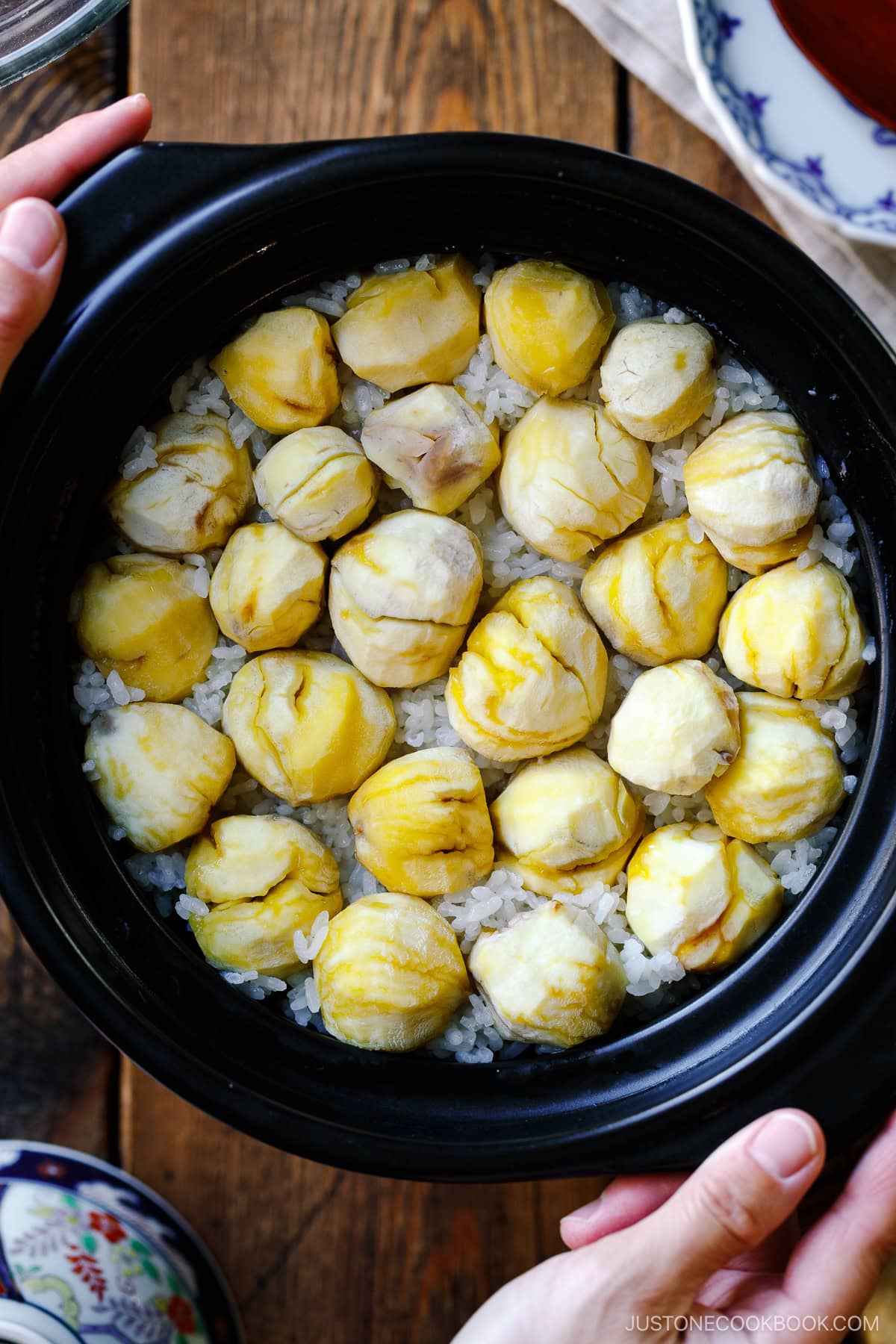
Autumn brings an abundance of delicious seasonal produce like Japanese chestnuts. Each fall, I eagerly anticipate the special dishes we make with them like today’s recipe for nutty and sweet Japanese Chestnut Rice (Kuri Gohan). It’s one of the signature dishes that marks the arrival of autumn in Japan—a fragrant, comforting dish that brings back fond memories.
For more rice dishes featuring fall produce, try my Japanese Sweet Potato Rice, Matsutake Gohan (Wild Pine Mushroom Rice), and Japanese Mushroom Rice next!
What is Chestnut Rice (Kuri Gohan)?
Chestnut rice, or kuri gohan (栗ご飯), is a traditional Japanese dish made with rice (gohan) and fresh Japanese chestnuts (kuri), two autumn crops in Japan. Kuri is culturally significant in Japan, serving since ancient times as an important food source during autumn and winter. It’s also believed to bring good luck and fortune. Today, we enjoy their deep nutty aroma and sweet flesh in delicious dishes like kuri gohan as a wonderful way to welcome the season.
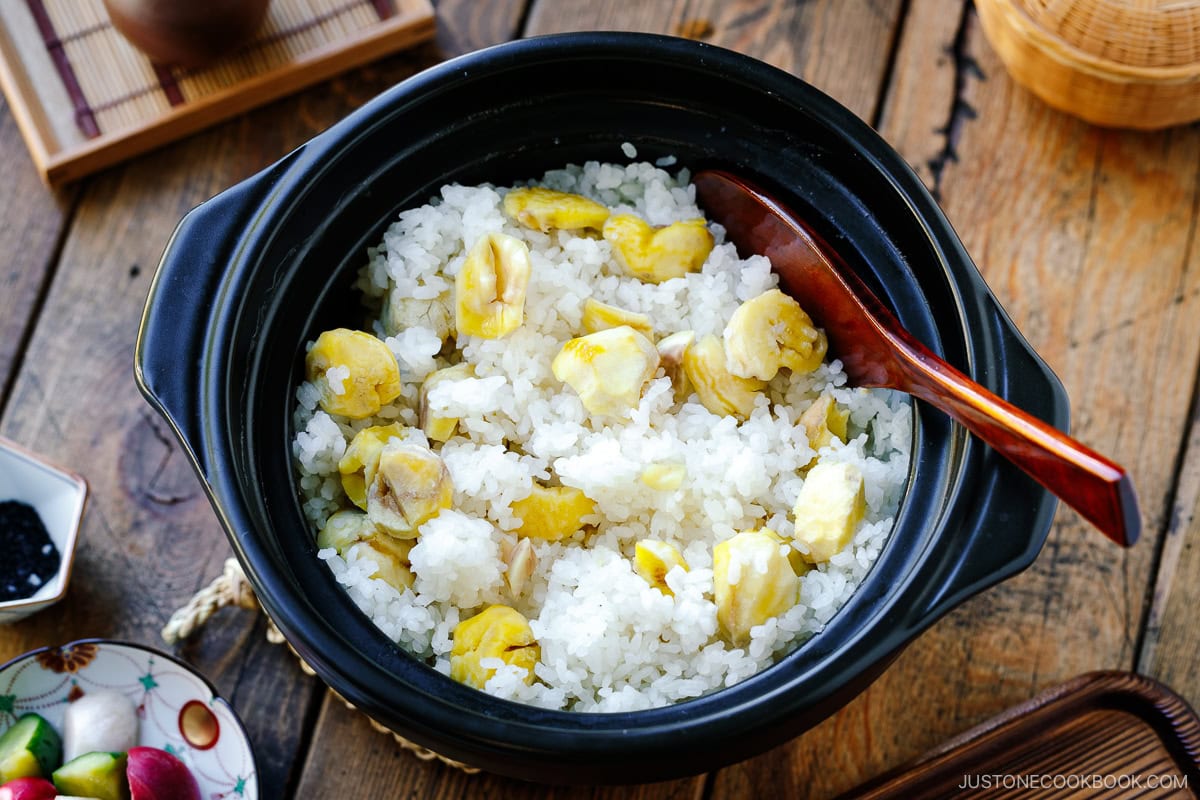
Why I Love This Recipe
- What a special, seasonal dish! Chestnuts are a precious cultural ingredient in Japan. When I make this dish, it sparks conversation and a cultural connection with my kids.
- Simple yet strikingly impressive. The beauty of this rice dish lies in its simplicity. The appearance of chestnuts captures the essence of fall and evokes a sense of nostalgia.
- Its aromatic flavor and fluffy texture are irresistible. There’s nothing like the combination of fresh Japanese chestnuts and new crop short-grain rice. I hope you give this recipe a try!
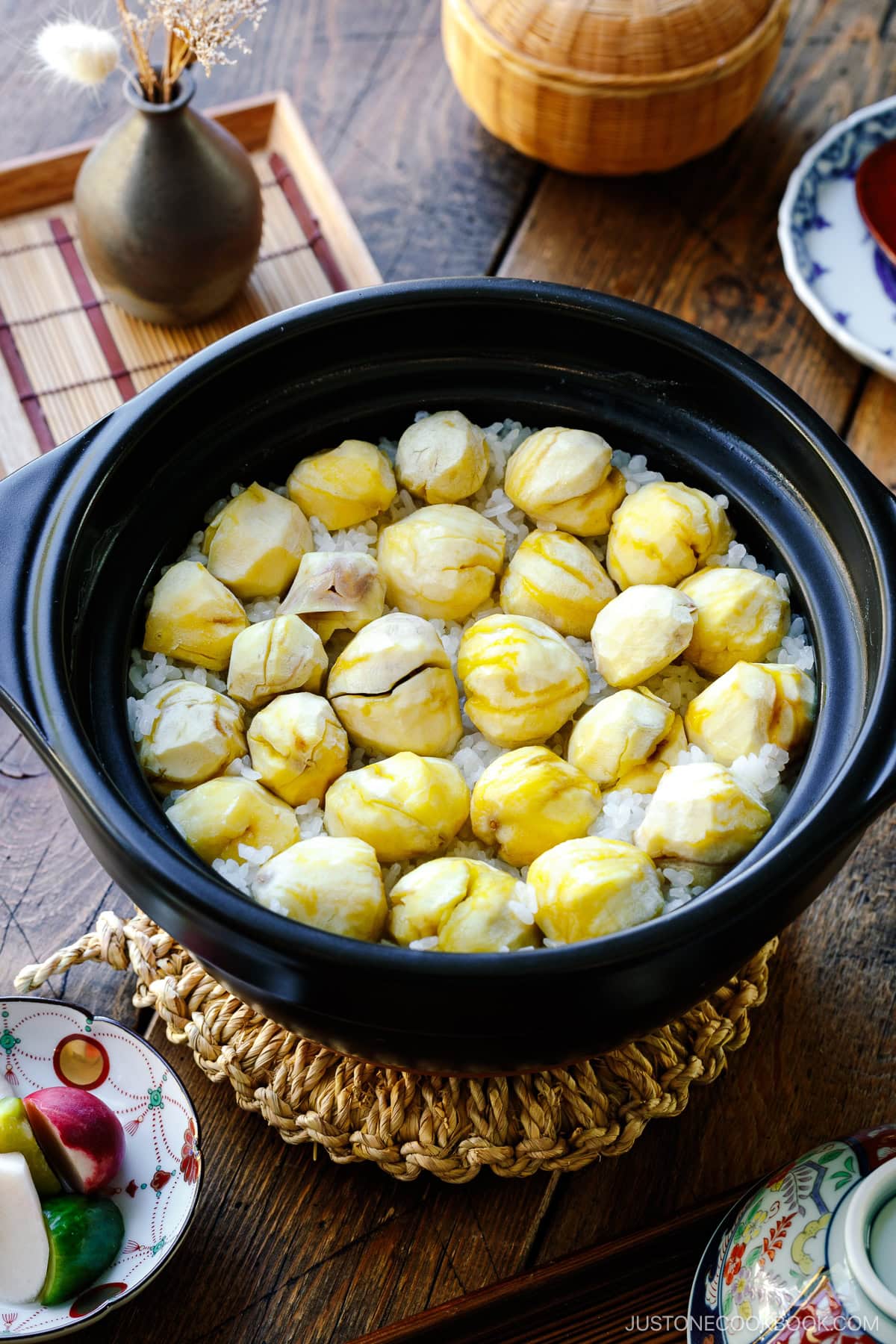
Ingredients for Chestnut Rice
Find the printable recipe with measurements below.
Substitutions
- Japanese rice: I highly recommend using Japanese short-grain rice here, as its texture and flavor differ significantly from other varieties. You can also use Korean short-grain rice, which is the closest alternative.
- Glutinous rice: I add Japanese short-grain glutinous rice to the mix for a slightly chewy and more tender texture. If you don’t have it, you can use Japanese short-grain rice instead.
- Sake: We add sake to infuse the rice and ingredients with flavor that enhances the richness and umami of the mixed rice. If you don’t have it, you can just skip it.
Key Equipment
- A heavy-bottomed pot – I use a Hario Gohangama donabe, a Japanese ceramic/earthenware pot, but you can use a Dutch oven instead. You can also make this recipe using a rice cooker; simply press start and cook as usual.
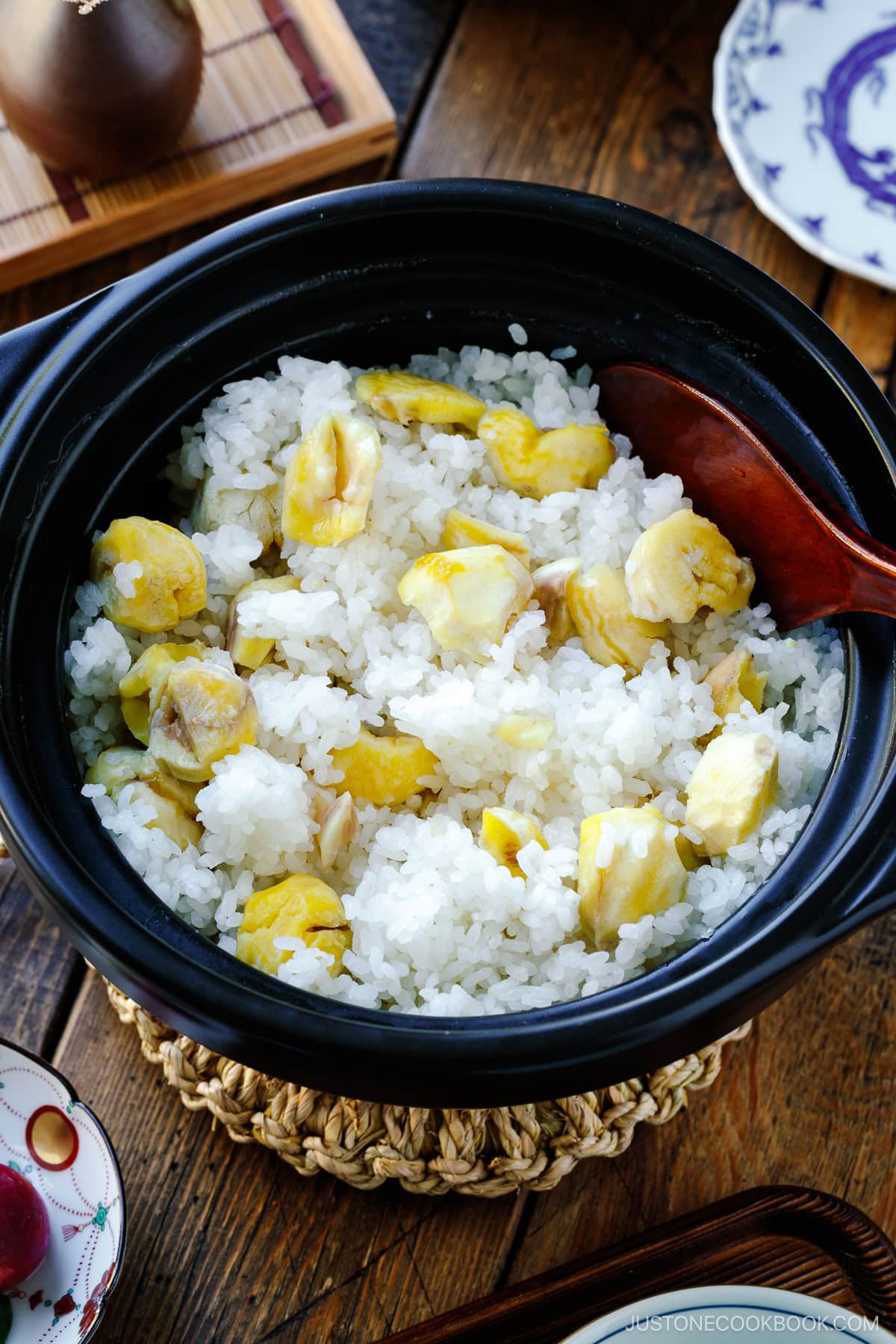
How To Make Chestnut Rice (Kuri Gohan)
Preparation
Step 1 – Remove the tough outer shell and the thin, papery inner skin. Soak the chestnuts in warm water for 30 minutes. For each chestnut, use a knife to remove the tough bottom, then peel off a strip along one side moving toward the tip. Peel away the outer shell with your fingers. The papery skin usually comes off with the shell.
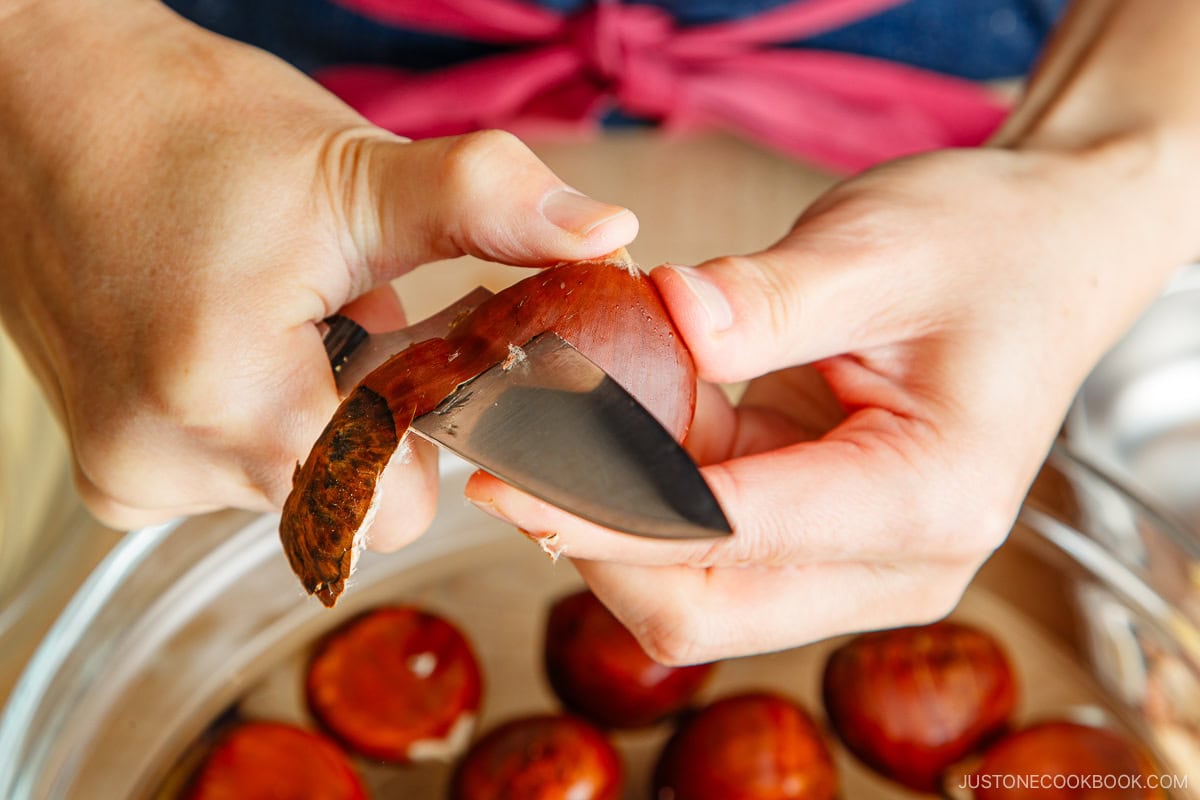
Step 2 – Peel away the bumpy flesh and shape the chestnuts. For a more attractive presentation, it’s best to make large cuts on the surface of the chestnuts to resemble the facets of a diamond.
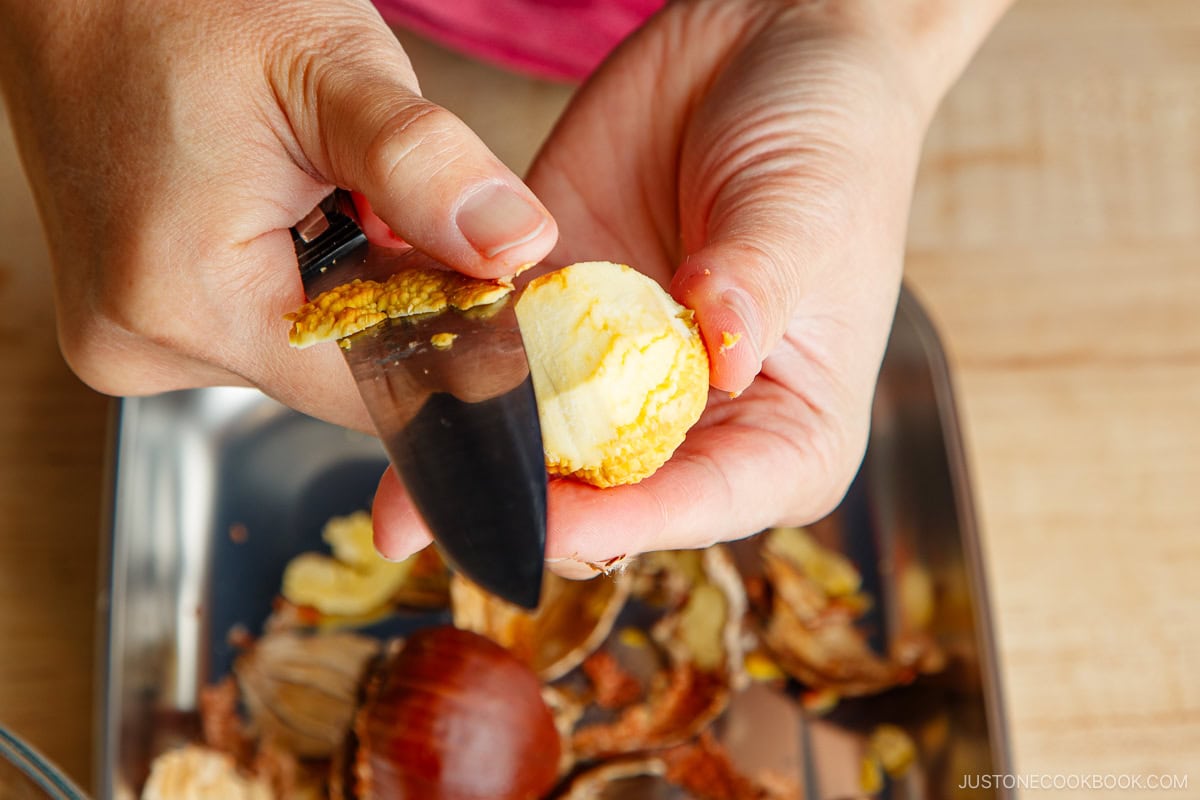
Step 3 – Soak the chestnuts in water for at least 30 minutes. This helps remove astringency and yields a beautiful creamy yellow color. Don’t skip this step.
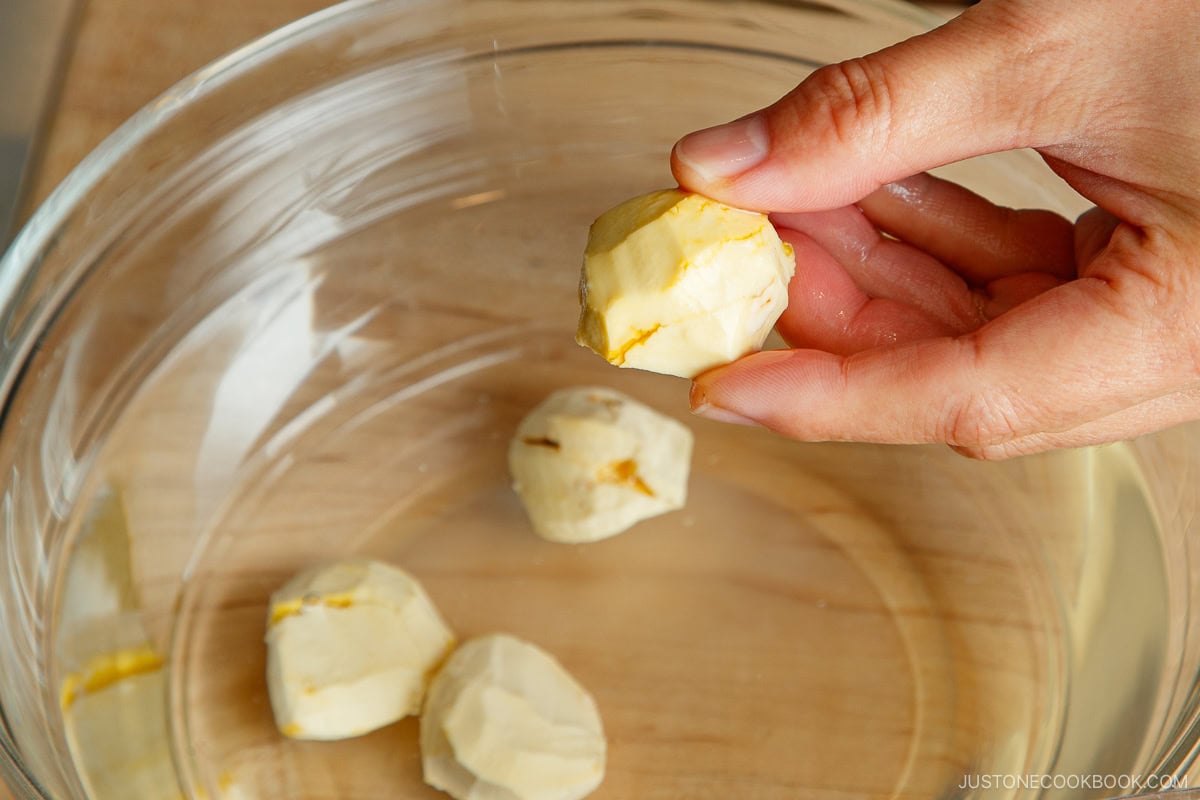
Assemble
Step 4 – Put everything in the pot. Add the rinsed and well-drained rice, measured water, and seasonings to the pot. Then, place the chestnuts on top in a single layer so they cook evenly. Soak for 20–30 minutes before cooking to allow the rice’s core to absorb moisture.
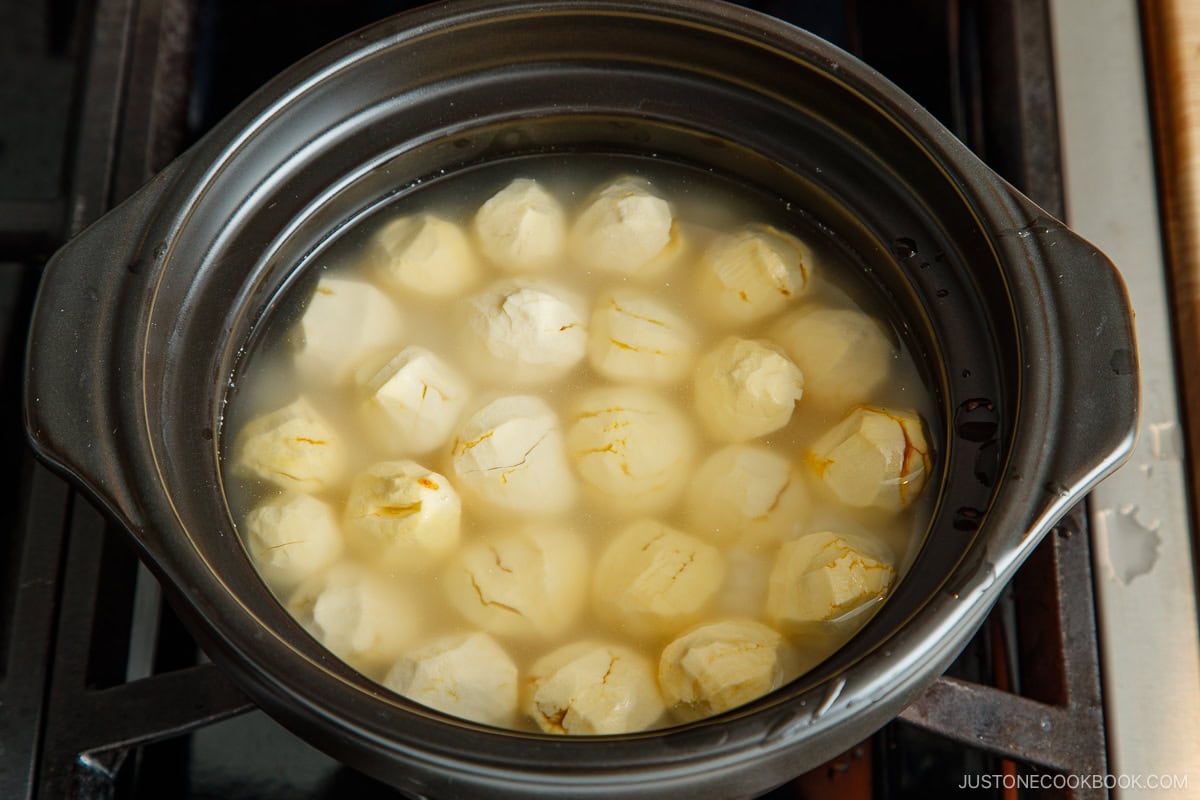
Cooking
Step 5 – Cook and steam the chestnut rice. For my donabe rice pot, I cook on medium-high heat for 12–13 minutes. When the cooking time is up, remove it from the heat and let it steam with the lid on for 15–20 minutes.
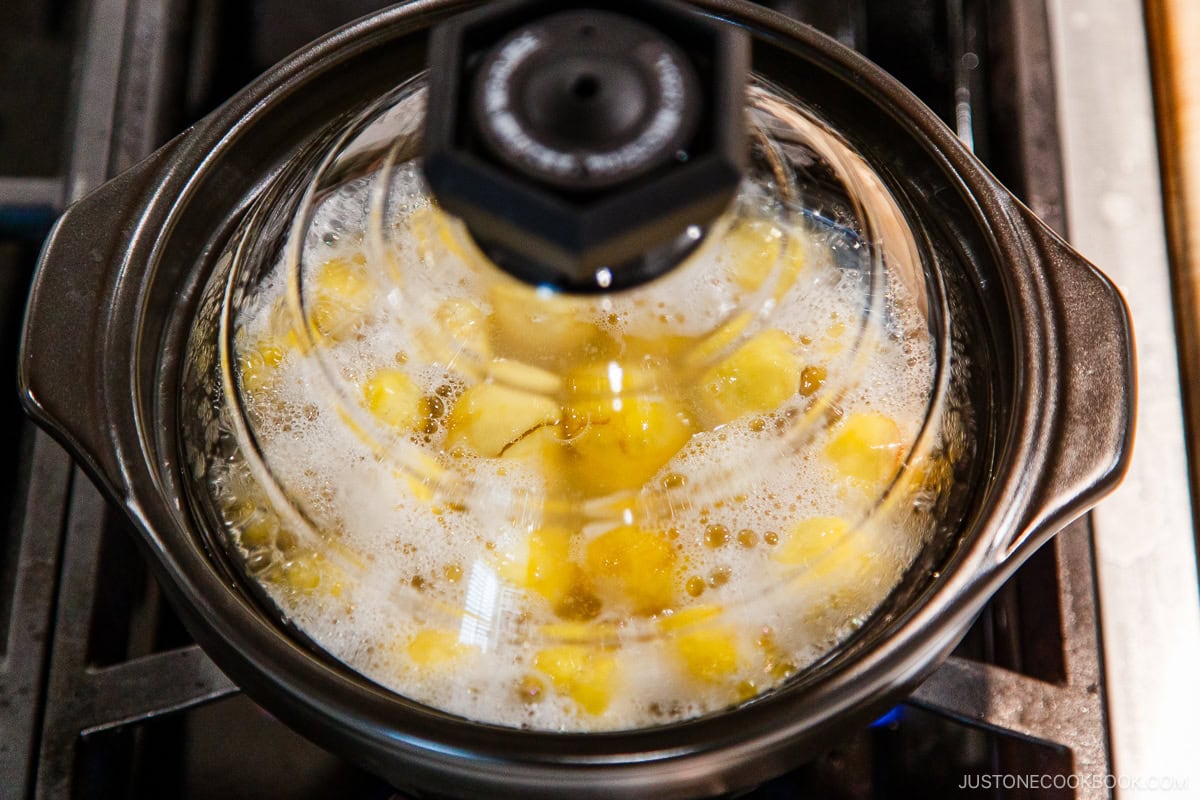
Step 6 – Fluff the rice. Set aside several beautiful chestnuts for serving, then gently fluff the rice with the rest of the chestnuts.
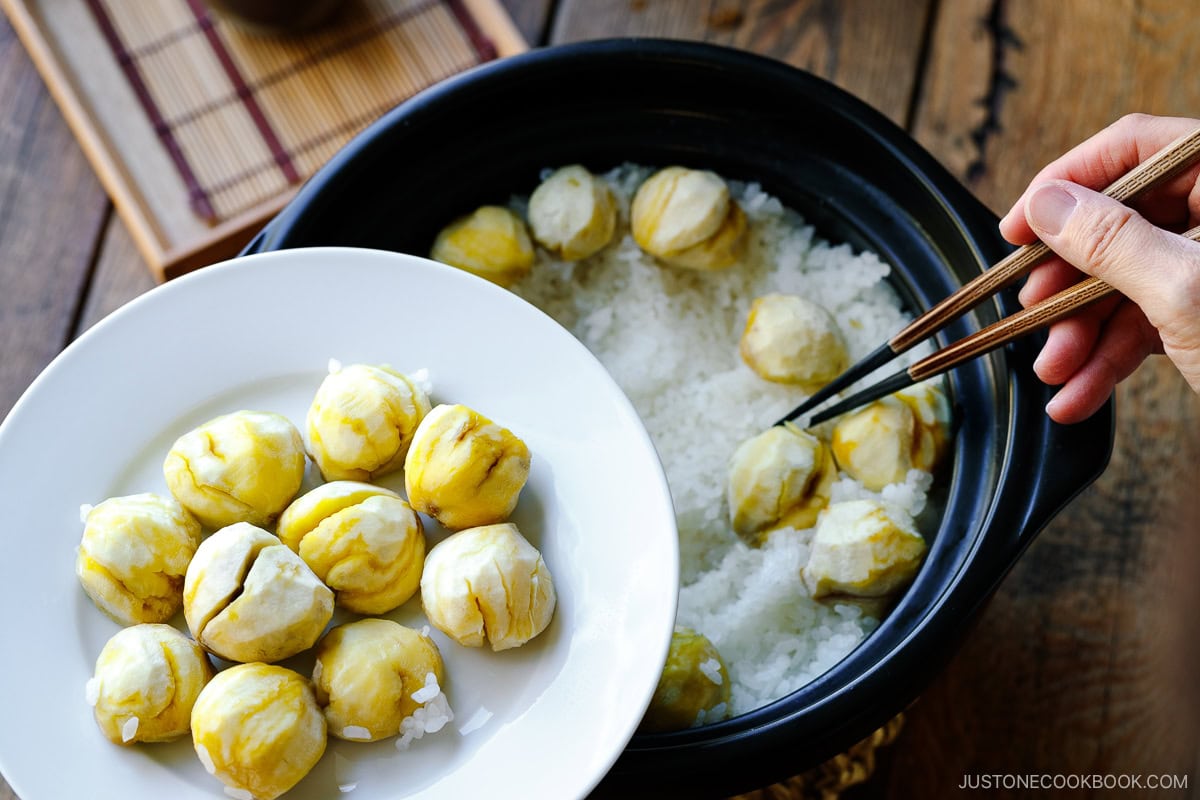

Step 7 – Serve. Serve in individual rice bowls and sprinkle with black sesame seeds and salt.
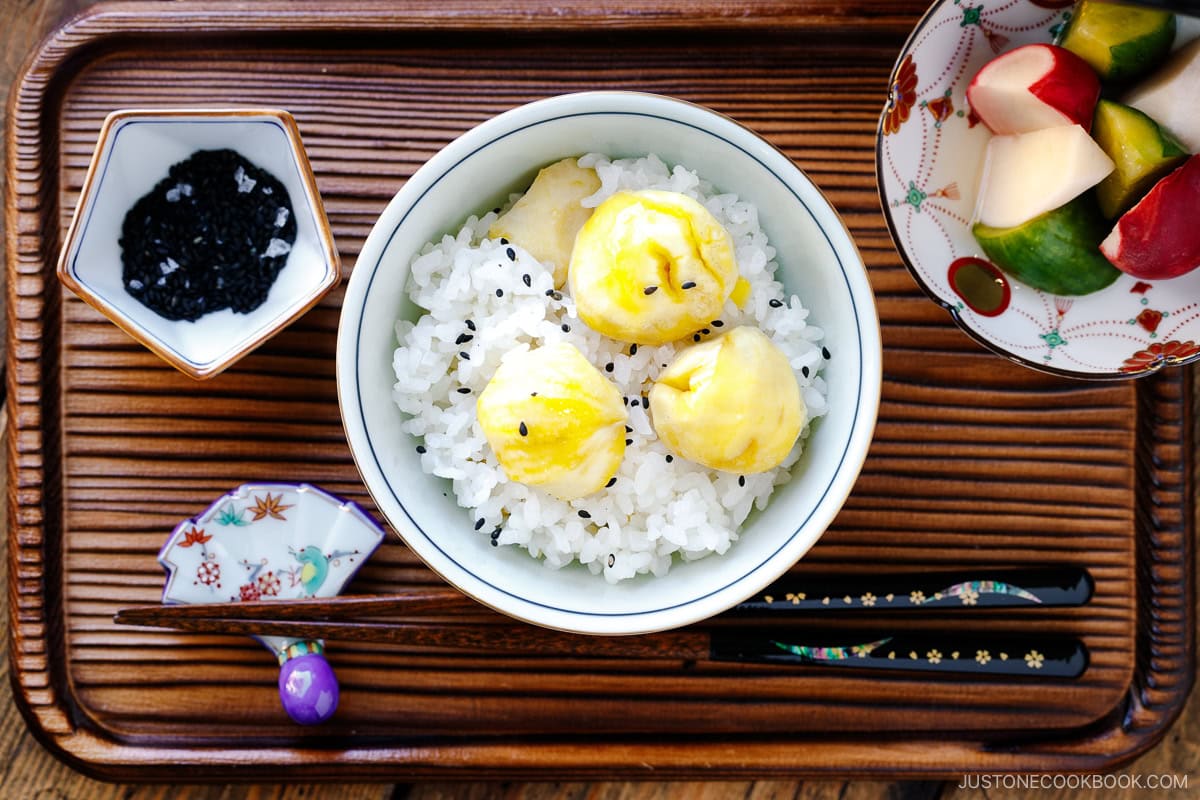
Nami’s Recipe Tips
- Get fresh chestnuts and use them within 3 days. I recommend storing them in the fridge in a breathable bag.
- Soak in warm water before peeling for 30 minutes. Some Japanese recipes use cold water, but I find that warm water helps. To keep the chestnuts moist and fragrant, we typically do not boil or roast them before cooking with the rice.
- Soak in cold water after peeling for 30 minutes. This helps create a beautiful yellow color. Without soaking, the chestnut will turn brown. Be sure to change the water a few times during this soaking period.
- Reserve some chestnuts for presentation. Once the chestnut rice is done steaming, remove several beautiful chestnuts from the pot to use for presentation when serving. They break easily after fluffing the rice, so it’s a good idea to set aside some whole chestnuts.
Variations and Customizations
- Enhance the flavor with dried kelp seaweed. Some people add a small piece of kombu between the rice and chestnut layers during cooking to increase umami and aroma.
- Add more seasonings. I keep my seasonings simple to let the naturally sweet and nutty chestnut flavor shine. If you wish, you can add a bit of soy sauce and/or mirin (Japanese sweet rice wine) to the cooking liquid in addition to the sake and salt. Just be sure to reduce the amount of water in the recipe; you’ll want to keep the overall measurement of cooking liquid the same.
- Skip the glutinous rice. You can make chestnut rice without glutinous rice. It will be less soft and tender overall, but it won’t become too hard the next day since there is no glutinous rice in it.
What To Serve with Chestnut Rice
I enjoy serving fragrant chestnut rice with various side dishes to create a full meal. Here are some suggestions, but feel free to mix and match:
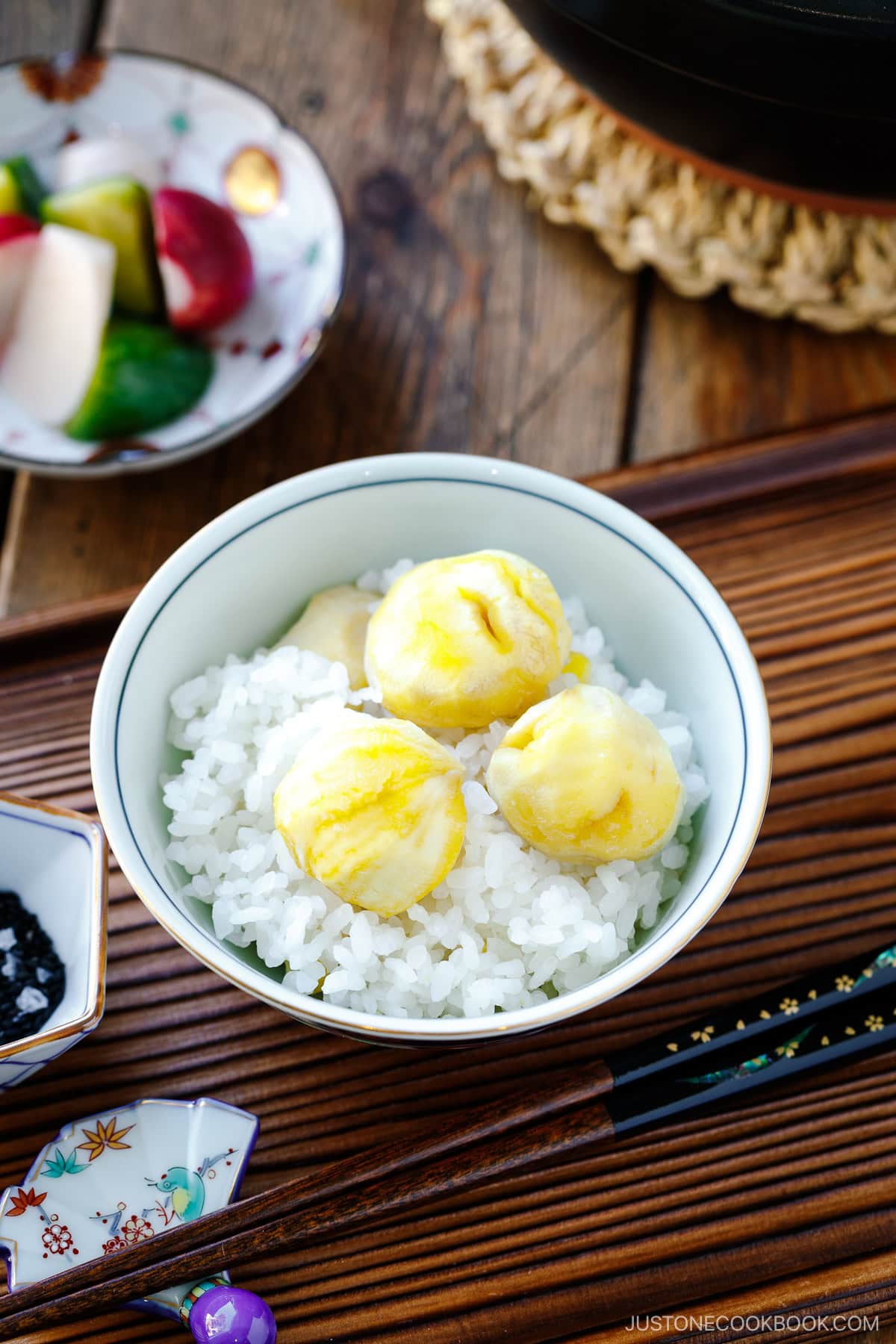
Storage and Reheating Tips
To store: You can keep the leftovers in an airtight container and store in the freezer for up to a month.
To reheat: Take out the glass container of frozen rice from the freezer. Remove the lid and loosely cover the rice with a paper towel. Then, microwave until the rice is hot all the way through.
Frequently Asked Questions
I can usually peel a chestnut shell by holding it in one hand and a pairing knife in the other. However, if the shell is tough and stubborn, place the chestnut on a cutting board to cut off the bottom, and then pick it up to peel off the shell.
Depending on the chestnut, the outer shell and papery inner skin may come off together. If the inner skin is still attached to the yellow flesh, then thinly peel off the bumpy flesh and papery inner skin together with the knife.
Unfortunately, no. I developed this recipe to use Japanese chestnuts, which are much larger than American/European chestnuts. Their cooking methods differ as well, since American/European chestnuts are typically roasted, not boiled. If you end up trying with them, let us know how it went. Please be careful removing the tough skin!
More Mixed Rice Recipes
There are so many ways to prepare Japanese mixed rice, and I think you’re going to enjoy these delicious recipes, too:
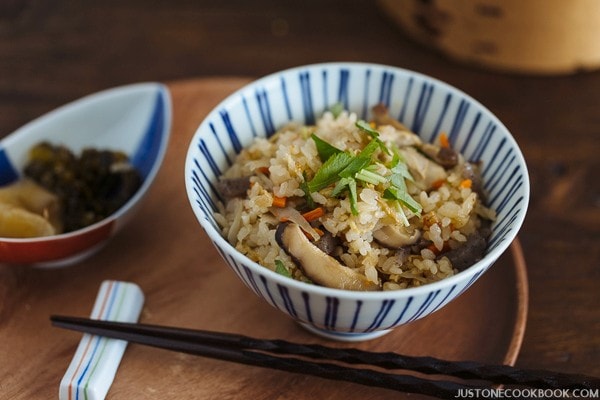
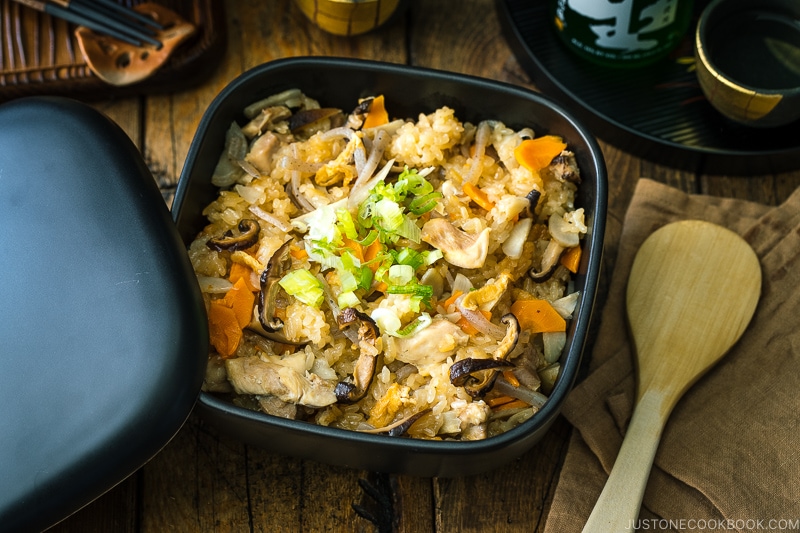
Prevent your screen from going dark
To Prepare the Chestnuts
-
Soak 20–25 chestnuts in warm water for at least 30 minutes. Some Japanese recipes use cold water, but I find warm water helps. To keep the chestnuts moist and fragrant, we typically do not boil or roast them before cooking with the rice.
-
Hold a chestnut in one hand and a pairing knife in the other. Carefully insert the corner of the knife under the bottom of the chestnut where the flat sides meet. Then, peel and remove the entire bottom. Tip: When the shell is tough and stubborn, place the chestnut on the cutting board, cut off the bottom, and then hold it to peel off the shell.
-
Next, peel off a strip of shell along the side toward the chestnut tip.
-
You should be able to peel off the outer shell with your fingers. Depending on the chestnut, the outer shell and inner skin may come off together, exposing the yellow flesh. The inner skin is the thin, papery brown layer that adheres to the nut itself.
-
To create a beautiful presentation, peel away a thin layer of the bumpy chestnut flesh using the pairing knife. It’s best to create a few wide, large cuts like the facets of a diamond rather than many small cuts. Soak the peeled chestnuts in a bowl of water for at least 30 minutes, changing the water a few times. Peel and soak the rest of the chestnuts.
-
This one still has the thin, papery inner skin is still attached. Thinly peel off the bumpy flesh and inner skin together.
-
Some chestnuts have folds and crevices where the outer shell is wedged. Use the edge of the knife to remove them. After soaking in a few changes of water, the chestnuts are a beautiful color. Tip: If your chestnuts are big, and cut them in half so that they cook evenly.
To Prepare the Ingredients
-
Put 1⅞ cups uncooked Japanese short-grain white rice and ⅓ cup sweet rice/glutinous rice (mochigome) in a large bowl. Gently wash the rice with cold water and discard the cloudy water. Repeat this process about 3–4 times until the water becomes almost clear. Drain well.
-
Put the well-drained rice and 2¼ cups water in a heavy-bottomed pot; I used a Hario Gohangama donabe, but you can use a Dutch oven instead. Tip: You can also cook this in a rice cooker.
-
Add 1 Tbsp sake and ½ tsp Diamond Crystal kosher salt to the pot. Gently mix it all together, then level the rice.
-
Place the chestnuts on top in a single layer, with the rounded sides facing up. Cover and let it soak for 20 to 30 minutes.
To Cook the Chestnut Rice
-
Bring the rice to a boil over medium heat. Take a quick peek to see if the water is boiling (otherwise, do not open the lid). Once the water is boiling, turn the heat to low and cook covered for 12 to 13 minutes, or until the water is completely absorbed (take a quick peek). If there is still water left, close the lid and continue cooking for a little longer. If you’re using the Gohangama, cook on medium-high heat until it starts to whistle, then cook for an additional 1 minute. Tip: If using a rice cooker, simply press Start and cook as usual.
-
Remove the pot from the heat. Keep the lid on and let the rice steam for 15–20 minutes. This steaming time is a crucial part of the cooking process, so please do not skip it.
To Fluff and Serve
-
Open the lid and set aside the best-looking chestnuts on a plate for serving.
-
To fluff the rice, insert a rice paddle vertically into the cooked rice. Turn over a scoop of rice from the bottom. Then, use a slicing motion to separate the grains and gently incorporate the chestnuts. Repeat until fluffed. Serve the rice and top with the reserved chestnuts. Optionally, sprinkle Diamond Crystal kosher salt and toasted black sesame seeds on top.
Calories: 391 kcal · Carbohydrates: 86 g · Protein: 6 g · Fat: 1 g · Saturated Fat: 1 g · Polyunsaturated Fat: 1 g · Monounsaturated Fat: 1 g · Sodium: 227 mg · Potassium: 231 mg · Fiber: 3 g · Vitamin A: 9 IU · Vitamin C: 14 mg · Calcium: 27 mg · Iron: 4 mg
Editor’s Note: This post was originally published on November 27, 2013. It was republished on November 4, 2024, with new images, a revised recipe, and more helpful information.
Discover more from reviewer4you.com
Subscribe to get the latest posts to your email.





